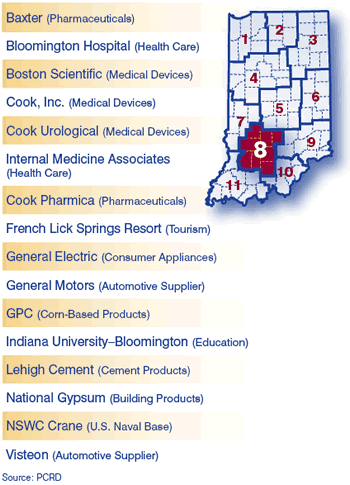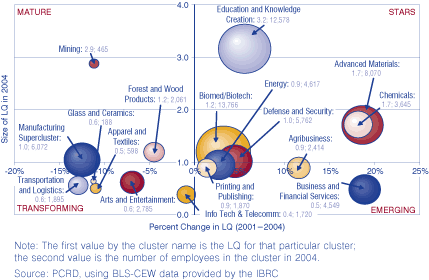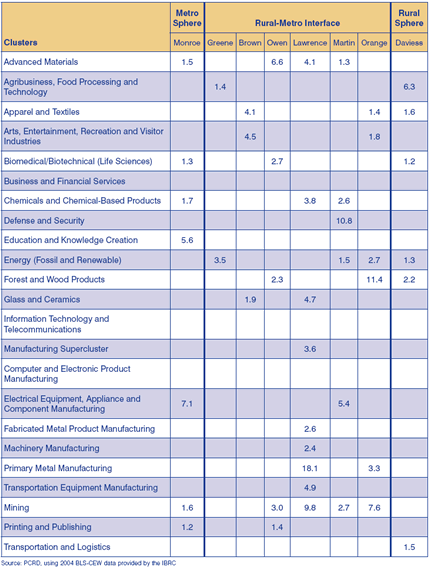Applying Cluster Insights in a Rural Region
Clusters are a useful tool for strategic planning in rural regions. A recent study yielded a national database and a process to serve as a prototype for rural regional development planning and action throughout the country. (1) The study was funded by the U.S. Economic Development Administration and conducted by the Purdue Center for Regional Development, the Indiana Business Research Center at Indiana University's Kelley School of Business, and Strategic Development Group, Inc.
This article highlights a portion of this work, which used Economic Growth Region 8 (EGR 8) as a pilot region to mobilize local stakeholders in a planning process that was grounded in both secondary data analysis and local primary data collection.
EGR 8 Overview
Indiana's EGR 8 is a primarily rural region, (2) although Indiana's seventh most populous city, Bloomington, is located in Monroe County. Aside from Monroe County, with a population of 121,407 in 2005, most of the region's counties have relatively small populations, ranging from 10,386 (Martin County) to 46,403 (Lawrence County). Table 1 shows the best-known employers in EGR 8.
Table 1: Well-Known Employers in EGR 8

The Planning Process
A local 25-member Regional Advisory Committee (RAC) oversaw the planning process for EGR 8. Each county's lead economic development official served on the committee, as well as eight members of the Purdue Cooperative Extension Service from counties in the region. Representatives from business, government, regional planning organizations and the nonprofit sector fleshed out the group. Combining the results from cluster analysis with ground-level information helped the committee develop strategies for regional cluster activation.
Cluster Analysis
For each of the 17 industry clusters, Figure 1 shows employment, the location quotient (LQ, a measure of relative cluster concentration) and change in LQ. (3)
Figure 1: EGR 8 Cluster Size, Location Quotients and Percent Change in LQ, 2001–2004
*********************************************************************
Location quotients show where industry sectors are more strongly concentrated in particular localities than they are in the nation as a whole. To the extent that a particular location quotient is greater than 1, the area is considered to be more specialized in that industry or cluster than the nation is, and industries in the cluster are assumed to be producing for export outside the area as well as for local consumption.
- Stars: clusters that are relatively specialized (LQ > 1) and are becoming even more specialized over time within the study area
- Emerging: clusters that are relatively unspecialized (LQ < 1) but are becoming more specialized over time within the study area
- Mature: clusters that are relatively specialized (LQ > 1) but are becoming less specialized over time within the study area
- Transforming: clusters that are relatively unspecialized (LQ < 1) and are becoming even less specialized over time within the study area
*********************************************************************
The highest location quotients in EGR 8 were associated with six clusters: education and knowledge creation; mining; advanced materials; biomedical/biotechnical; chemicals and chemical-based products; and forest and wood products. Four of these clusters had increasing LQs (meaning they became even more concentrated) from 2001 through 2004, with the advanced materials and chemicals clusters increasing quite dramatically.
Five clusters showed increased specialization during this period but still had relatively modest LQs: defense and security; agribusiness, food processing and technology; energy; printing and publishing; and business and financial services. The increase in the LQ for the latter cluster was substantial, increasing by nearly 20 percent.
Six clusters had relatively low LQs and also saw their LQs decrease from 2001 through 2004: manufacturing; arts, entertainment, recreation and visitor industries; glass and ceramics; transportation and logistics; apparel and textiles; and information technology and telecommunications.
Many of the region's main economic assets are located in Monroe County. Figure 2 shows the LQs of industry clusters in the region excluding Monroe County.
Figure 2: EGR 8 Minus Monroe County: Cluster Size, Location Quotients and Percent Change in LQ, 2001–2004
Table 2 shows each county in the region and its specialized clusters. The counties are all quite different with respect to the local concentration of their cluster industries. While EGR 8 as a whole has a diverse and reasonably robust cluster array, each county (with the exception of Monroe and to some extent Lawrence) has a relatively small number of cluster strengths when taken individually.
Table 2: Clusters with Location Quotients of 1.2 or More in EGR 8 Counties, 2004
This distribution of cluster assets suggests a two-pronged strategic approach. First, the region should attempt to take advantage of existing cluster strengths in its more rural areas. Second, the strategy should create stronger connections between the lesser developed areas and the more developed metro area of Monroe County. This latter approach might pursue a variety of tactics: workforce development, vendor relationships and entrepreneurship.
Ground-Level Data
To supplement the cluster analysis, the planning team collected additional local information through interviews, focus groups and a survey of business executives.
Interviews and Focus Groups
The planning team met with five of the six mayors in the region for in-depth interviews. The mayors, as a whole, were extremely supportive of the planning effort and offered to participate in implementing the new strategy.
In addition, regional focus groups explored the following topics:
- Arts, Entertainment, Recreation and Visitor Industries
- Biomed/Biotech and Advanced Materials
- Defense and Information Technology
- Agribusiness, Forest and Wood Products, and Energy
EGR 8's Business Climate Survey
Respondents rated the importance of several local factors to the success of their businesses. (4) Four factors stood above the rest in importance (rated very or moderately important by more than 70 percent of those responding): workforce quality, responsive local government officials, labor availability and being close to customers.
As shown in Table 3, nearly half the respondents considered the availability of labor to be excellent or good for management and administrative salaried workers. Overall, the labor supply was best for unskilled workers. Perhaps not surprisingly, these unskilled workers were also rated as lower in quality than the other categories of labor. Management and administrative workers, on the other hand, had the strongest quality ratings with 65 percent rating them either excellent or good.
Table 3: Ratings of Labor Availability and Quality in EGR 8, 2006
When discussing regional assets, the most frequent observations concerned the good quality of life in the region, shaped by a variety of factors such as recreational and cultural opportunities, beautiful natural environment, high quality health care, low crime, affordability, and the relaxed pace of life compared to urban areas. Some of the region's more prominent economic assets were also mentioned frequently, including its higher education institutions, the strong life sciences cluster, and the Crane Naval Surface Warfare Center. The region's location was often viewed as a strength, reasonably close to many larger cities and markets and centrally located within the United States.
When discussing regional liabilities, the most common drawback concerned poor transportation infrastructure and the impact this has, together with long distances to larger cities, on access to markets and services. Contrasting with the advantage cited earlier of having access to strong higher education institutions is the relatively low educational attainment of the workforce and the general population.
Cluster Strategy
The RAC ultimately selected the following cluster groups to be the focus of regional development efforts:
Energy; Agribusiness, Food Processing and Technology; Forest and Wood Products: Potential exists for significant growth given the current strength of this cluster and the opportunities for alternative energy—especially in biomass.
Biomedical/Biotech; Advanced Materials: The committee is looking to activate a hospital/health care roundtable to help small, local health care groups thrive in a difficult rural environment and to help small advanced materials and manufacturing firms retool to supply the growing biotech sector.
Arts, Entertainment, Recreation and Visitor Industries: This cluster has a number of possibilities, ranging from a series of regional festivals to year-around exhibits of the work of regional artists.
Transportation and Logistics: The committee not only saw this cluster as a major future area for activation (with the expansion of I-69) but also as a major enabling and supporting cluster for expanding business and cultural tourism.
Defense and Security: Because NSWC Crane is the second largest employer in southwest Indiana, this cluster is critical to the region's economic future. Three counties in the region have already pioneered a new tech park on the west side of Crane. At least one county is planning a similar park on the east side. Enabling all eight counties to gain from Crane's economic engine is important.
Business and Financial Services: The RAC felt the region was underserved in this cluster and wants to continue developing it.
Next Steps
The planning team continues to talk with potential funders about providing resources to enable implementation. If funding can be found, implementation could begin in 2007.
Notes
- A grant from the U.S. Economic Development Administration supported this study to examine industry clusters in rural communities as a basis for economic development and strategic planning. To read the full report, Unlocking Rural Competitiveness: The Role of Regional Clusters, or to access maps and the online database, visit www.ibrc.indiana.edu/innovation/.
- EGR 8 consists of Brown, Daviess, Greene, Lawrence, Martin, Monroe, Orange and Owen counties.
- For more detail on location quotients and definitions of the 17 clusters, see the full report at
www.ibrc.indiana.edu/innovation/reports.html. - The 112 responding organizations were generally long-term residents of the region and only 17 percent were headquartered outside of EGR 8. Forty-six percent of the organizations in this sample were located in Monroe County.
Christine Nolan, Senior Associate
Purdue Center for Regional Development, Purdue University
Thayr Richey, President
Strategic Development Group
Jerry Conover, Director
Indiana Business Research Center, Kelley School of Business, Indiana University




